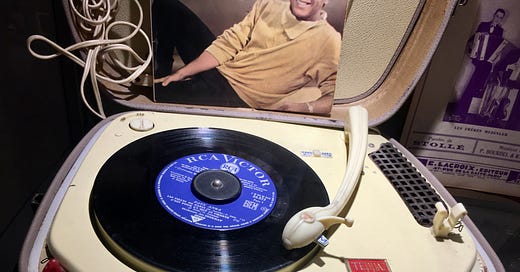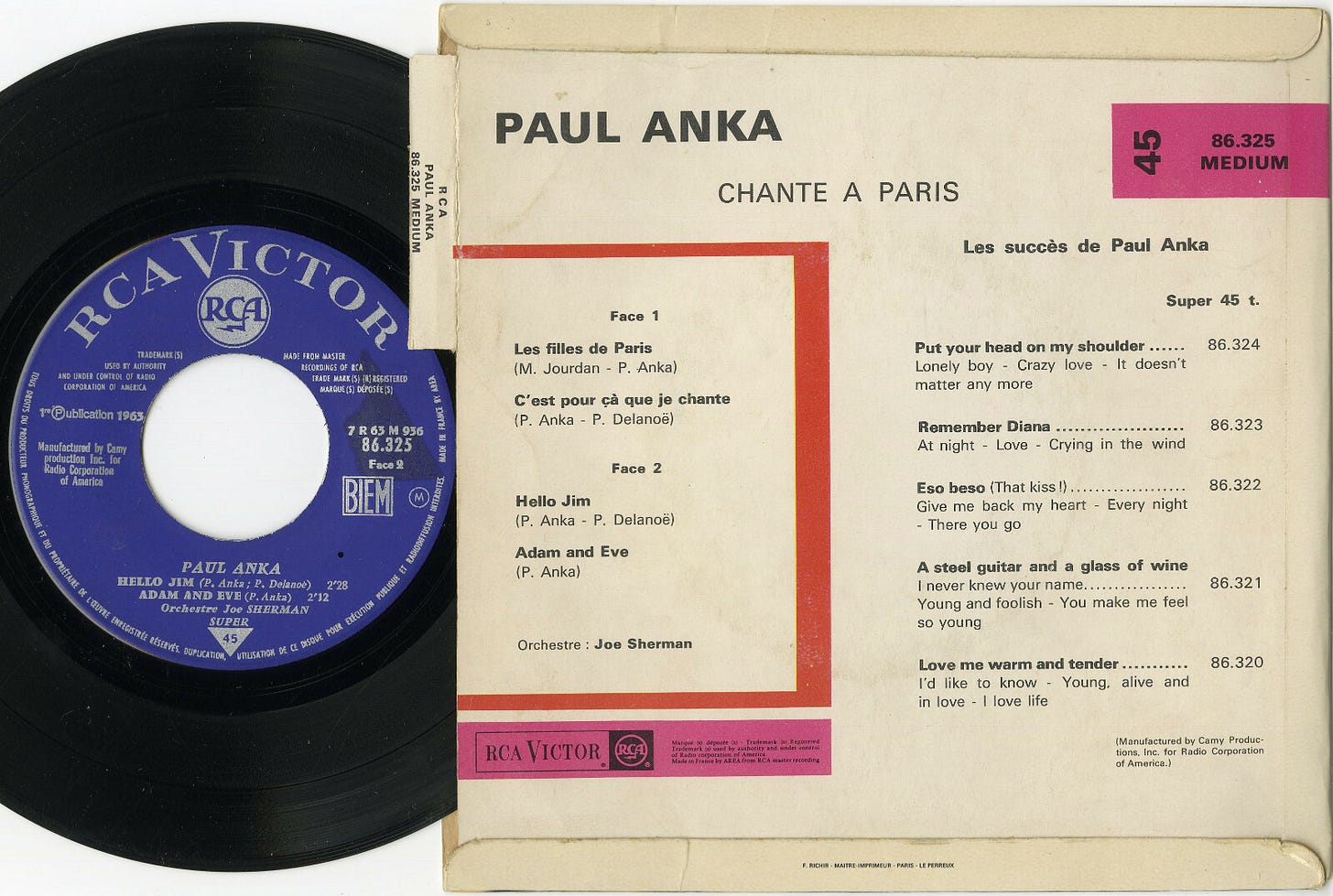Portable record player – the Oscar goes to Teppaz
… the sound of modernity … and freedom … the sound of the Sixties …
For only one day in my life, 50 years ago, I saw, touched, and heard the most incredible music machine of my life. I saw it for the second time yesterday, in April 2025, and I was just as mesmerized. But it was behind a glass exhibition case – untouchable and silent – with a 1963 Paul Anka record on the turntable.
The Oscar for Best French Export Company in 1962 goes to Marcel Teppaz and his manufacturing business, called Teppaz. His most successful product was the “Oscar” model of his innovative portable record player, the medium for listening to vinyl microgroove records. It was a small briefcase with a turntable – the “Portable Teppaz” – which became an icon of postwar innovation and pop culture. In the 1950s and 1960s, few objects captured the spirit of youthful freedom and musical exploration in France like the Portable Teppaz Oscar.
The Portable Teppaz Oscar was one of the first truly portable record players, allowing music lovers across France to bring their records into parks, onto riverbanks, or to gatherings in cafés and apartments. It democratized music listening at a time when access to records was becoming more affordable.
Marcel Teppaz, born on 26 May 1908 in Serrières-de-Briord, France, came from a family that manufactured spinning mill mechanisms. Marcel established his own radio and amplifier equipment assembly company in 1931 on Rue Jarente in Lyon. In 1937, he launched a new amplifier business with 30 people, moving into larger premises.
During the Second World War (1939-1945), the company closed and Teppaz entered the army. He was captured as a prisoner-of-war until his escape, although I couldn’t find details of this. In 1941, he had the idea of replacing the hand-cranked phonograph drive with a small electric motor which led to the assembly of the record player from 1952. In 1952, approximately 600 employees on the assembly lines on Boulevard de la Croix-Rousse in Lyon put together the 1,500 parts, selling 600,000 devices.
The Portable Teppaz Oscar was manufactured from 1958 to 1964, with the Oscar II model manufactured from 1964 to 1968.
The first compact, lightweight Portable Teppaz Oscar was a creamy-white Bakelite base and turntable with built-in speakers in a small briefcase with rounded corners, a domed lid, and a handle. The Oscar II was square-shaped. It had a tube amplifier consisting of a UCL 82 and a UY 85 – standard and reliable for the time. The electric motor operated at 220V so no transformer was needed.
It played three types of black, pressed vinyl records based on the revolutions per minute (rpm) – the speed that the record turned – but could play all record speeds: 16, 33, 45, and 78 rpms (78 rpm records ceased manufacture in 1959).
- 45 rpm records (with a single song on each side): 7 inches (18 centimetres).
- EP extended play records (with two or three songs on each side but up to eight tracks at 45 rpm): 7 inches (18 centimetres).
- LP long plays (a full album at 33 rpm): 12 inches (30 centimetres).
To be accurate, the Teppaz portable record player could be carried like a briefcase but did not work while you were walking down the street with it. It was portable in the sense that it could be easily moved from place to place — to a friend's house, a park, a picnic, etc.
To play a record, the device needed to be placed on a stable surface like a table, bench, or the ground. Records are sensitive to vibration and movement. If you tried to walk while playing the record, the needle (stylus) would skip or scratch the disc — or even damage both the needle and the vinyl. So, it was portable to carry but stationary to play.
The Oscar model sold millions of units locally and internationally, a true success until 1970.
Marcel Teppaz died on 15 August 1964 in Saint-Alban, France, from a heart attack. After his death, his wife and son-in-law continued the company's operations until 1974.
Today, the Teppaz Oscar remains a piece of vintage French design — a charming symbol of how music moved from the concert hall and cabaret to become a personal, portable companion.
There is now a resurrection of the portable record player due to the “vinyl revival.” The new models are cheap and convenient but the sound fidelity is not high – but neither were the original Teppaz models. Many companies are reproducing the concept – mainly for fun – and most still re-create the briefcase design, while some are retro 70s-style models, or more creative.
Although it took me 50 years to re-see the innovative French Portable Teppaz Oscar record player, after living in France, I had never forgotten its charm. It was the sound of freedom. And for me, it was modern, so excitingly modern.
Can’t see the whole article? Want to view the original article? Want to view more articles? Go to Martina’s Substack: The Stories in You and Me
MY PARIS WEBSITE AND ALL THINGS PARISIAN
Photographer: Martina Nicolls
PIP DECKS, the fun and engaging how-to guides for business.








